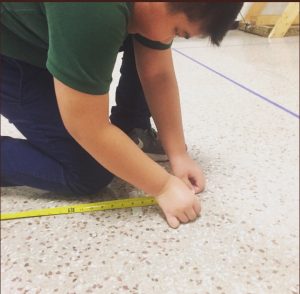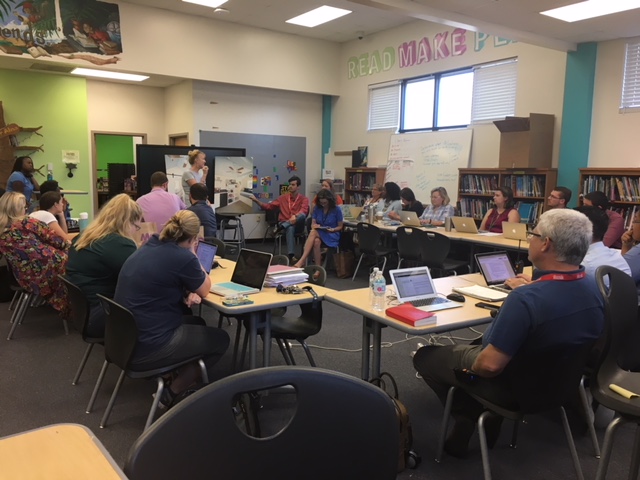By. Dr. Jimmie Cave and Lauren Kelly, The STEM Academy at Bartlett, and Peter Ulrich, Savannah-Chatham County Public Schools
Opening its doors in 2013, The STEM Academy at Bartlett is a public school in Savannah, Georgia that provides an innovative and rigorous educational experience for middle school students by cultivating an environment of engagement, exploration, and creativity. The integration of technology, specifically a 1:1 iPad program, forward-thinking research-based practices, and problem-based learning has revolutionized teaching and learning at The STEM Academy. Sound instructional practices and a deliberate approach to curriculum integration form the basis for recognition from a number of organizations, including first whole-school STEM certified middle school by the Georgia Department of Education, second whole-school STEAM certified middle school in Georgia, Distinguished Breakout School by the Georgia Association of School Psychologists, Apple Distinguished School, Georgia Lighthouse School to Watch, and National Forum School to Watch. In addition, The STEM Academy at Bartlett was named the #1 STEM middle school in the United States in 2016 by the Future of Education Technology Conference.
Curriculum design is a partnership at The STEM Academy at Bartlett. The STEM Academy creates and utilizes iTunesU courses to deliver curriculum, provide resources for learning, and allow for a succinct database of all content. Faculty work collaboratively to design curriculum, meeting at-large, in breakout groups, and digitally to compose and update all programs of study and resources. It is not uncommon to find fifteen to twenty faculty members, MacBook devices open and coffee nearby, huddled in the back of the media center on any given afternoon planning in what may be described as a visual symphony. With the support of school district leadership and the investment of time and resources from community partners, The STEM Academy at Bartlett is able to provide a unique learning experience for students.
iTunesU courses are broken into sections to facilitate learning and application to the National Academy of Engineering’s Grand Challenges for Engineering. Courses are available to students even when they are not currently enrolled in the course to facilitate autonomous learning and connection of different perspectives to Grand Challenge problem-solving. Students engage in step-by-step acquisition of knowledge and application of thinking. First, students explore topics and gather relevant information. In this section, students are free to act as a consumer of knowledge and inquire about a topic’s different perspectives. Second, students participate in an activity to synthesize learning in some sort of digital content. Students must demonstrate understanding of the topic and its application to the problem at hand. Third, students must create new content or media to begin to work toward a solution for the problem, and finally reflect on the solution and its application to the problem and world.
Playing a major role in the design of curriculum is the Grand Challenges. Based on the National Academy of Engineering’s Grand Challenges, these real-world problems push students to examine and solve some of the biggest issues facing their generation at the age of eleven, twelve, or thirteen. Students have analyzed how to engineer better medicines through personalized medicine, how to restore our failing infrastructure system through a global and national perspective, and how to provide access to clean water around the world. Students utilize their knowledge from each class to conquer these problems, and faculty members work collaboratively to achieve this goal using Apple devices and apps to plan. Nontraditional courses are available because of iPad integration, Apple apps, and innovative teachers. These courses, known as Apps at The STEM Academy, include Lego Robotics, Vex Robotics, Film and Broadcasting, MakerSpace, UAS/Drones, Geographic Information Systems (GIS), and Video Game Design. While reading Romeo and Juliet, it is a natural evolution for students to create a rollercoaster using Vex Robotics to track the conflict and character development while utilizing Newton’s Law. While reading The Giver, students not only design their own “utopia” community to scale based on math standards, but also create iMovie commercials using green screen technology to persuade others to join their community, all while designing their community’s water system to tie into their Grand Challenge.
Tackling real-word problems, especially those associated with the Grand Challenges, necessitates that students step beyond the four walls of the classroom and into their community. A perfect example of this is the Tiny House Project. Savannah has the unique opportunity of introducing the first tiny home community in the state of Georgia. This is not simply a group of tiny homes designed for hipsters or those wishing to live a minimalist lifestyle. Instead, these homes are for homeless Veterans who live in the community (one out of 16 homeless individuals in the Savannah area are Veterans). This project has been years in the making, but it was just recently that The STEM Academy at Bartlett became involved.

STEM Academy students design a prototype for the Tiny House Project. source: The STEM Academy at Bartlett
In the spring of 2018, Lauren Kelly, one of the school’s eighth-grade research teachers, began planning ways for students to be involved in the community while learning about improving infrastructure. It was first through Nine Line Apparel that the Tiny House Project was introduced. After further research, contact was made with the Chatham Savannah Authority for the Homeless (CSAH). Over the course of the summer, plans to have students observe infrastructure from ground zero began to take shape. Students have the opportunity to observe and participate in implementing plans to establish water and sewage connections, connecting to the electrical grid, paving roads, and erecting houses – everything that would happen in a new housing community, but on a “tiny” scale.
The Apps classes at The STEM Academy have truly immersed themselves in this project. Students in the MakerSpace class are designing and installing Murphy tables for the first twenty-four tiny homes being built in the fall of 2018. With the help of the Metropolitan Planning Commission, students who are enrolled in GIS will be working with a map showing the locations of each of the homeless camps in Savannah. With this information, students will create a map that will show homeless individuals the locations of restaurants and other facilities that provide assistance near them.
Scientific Research at The STEM Academy is designed to introduce research skills to middle school students while addressing real-world issues. With this project, we want to take things one step farther and address issues within our community. Most are familiar with project-based learning; however, with this project The STEM Academy is implementing service-based learning that will span the course of several years. The long-term goal set forth by CSAH is to have each tiny house equipped with solar panels. Future classes may have an opportunity to design solar panels and solar cells that could possibly be used on these homes while studying solar energy and alternative energy sources in their Physical Science course.
Using the Grand Challenges as a mechanism to support student learning through research, design, and application to solve real-world problems provides STEM Academy students with an authentic learning experience. Teachers intentionally use the Grand Challenges to get students to make connections with content material as well as embed opportunities for students to demonstrate 21st century skills such as critical thinking, creativity, collaboration, communication, and resilience.
In addition to the educational benefits of working through the Grand Challenges, STEM Academy students find enjoyment and purpose as they are able to use a variety of skills to formulate solutions to the problems they explore. It is truly amazing to witness the level of confidence students display as they present their findings to peers, teachers, and community partners. Preparing students to become significant contributors to our global society is the hallmark of intentional teaching and learning at The STEM Academy at Bartlett. The Grand Challenges fit well in support of that mission.
Author Bios
Dr. Jimmie Cave is a thirteen year veteran educator and current principal of The STEM Academy at Bartlett. Under his leadership, The STEM Academy has been recognized as the top STEM middle school in the state of Georgia, a STEAM Certified middle school, and most recently designated as a National Lighthouse School to Watch.
Lauren Kelly is an eighth-grade Scientific Research Teacher at The STEM Academy at Bartlett in Savannah, Georgia. Mrs. Kelly is a 2012 graduate of Methodist University in Fayetteville, North Carolina with a degree in chemistry. She completed her Master of Arts in Teaching Secondary Science in 2018 from Georgia Southern University – Armstrong Campus.
Peter L. Ulrich, Executive Director of Special Programs for the Savannah-Chatham County Public School System, has been in public education administration for 16 years. Knowing the foundational role that education, especially public education, has for communities, he is grateful for the opportunity to play a part in substantive change.

